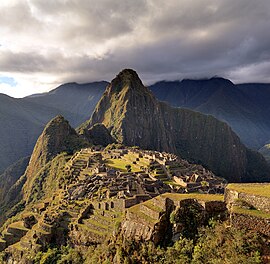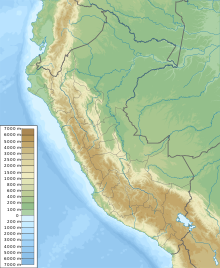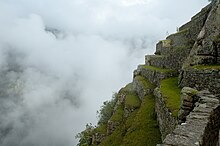| Historic Sanctuary of Machu Picchu * | |
|---|---|
|
Huayna Picchu towers above the ruins of Machu Picchu | |
| Country | Peru |
| Type | Mixed |
| Criteria | i, iii, vii, ix |
| Reference | 274 |
| Region ** | Latin America and The Caribbean |
| Inscription history | |
| Inscription | 1983 (Seventh Session) |
| * Name as inscribed on World Heritage List | |
 Machu Picchu as discovered in 1911
Machu Picchu as discovered in 1911On 24 July 1911, Hiram Bingham announced the discovery of Machu Picchu to scholars. An American historian employed as a lecturer at Yale University, Bingham had been searching for the city of Vilcabamba, the last Inca refuge during the Spanish conquest. He had worked for years in previous trips and explorations around the zone. Pablito Alvarez, a local 11 year-old Quechua boy, led Bingham up to Machu Picchu.Some Quechuas lived in the original structures at Machu Picchu.
The site received significant publicity after the National Geographic Society devoted their entire April 1913 issue to Machu Picchu.
In 1981 Peru declared an area of 325.92 square kilometers surrounding Machu Picchu as a "Historical Sanctuary". In addition to the ruins, the sanctuary
The ruins of Machu Picchu are divided into two main sections known as the Urban and Agricultural Sectors, divided by a wall. The Agricultural Sector is further subdivided into Upper and Lower sectors, while the Urban Sector is split into East and West sectors, separated by wide plazas.
The central buildings of Machu Picchu use the classical Inca architectural style of polished dry-stone walls of regular shape. The Incas were masters of this technique, called ashlar, in which blocks of stone are cut to fit together tightly without mortar. Many junctions in the central city are so perfect that it is said not even a blade of grass fits between the stones.








